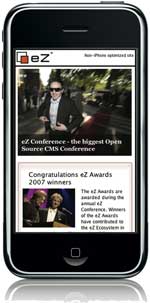 [Spring 2010 Edition: you need only describe the frontend interface and backend support in a 750-word commentary. This project will count 1/4 of the other projects.]
[Spring 2010 Edition: you need only describe the frontend interface and backend support in a 750-word commentary. This project will count 1/4 of the other projects.]
In this project, you will conceive and design the interface for an iPhone/iPod Touch app. The design will be represented by 5-10 screen shots and a 750-word commentary.
The app should be unlike any now available--a nearly impossible requirement unless you localize your focus to serve an audience too small or specific typically to have its own app: students in a specific UMD major, members of a local organization, residents of a particular town who share a common interest, etc.
Most fundamentally, your conception of the app should be based on the idea that digital documents are not objects, but filters. They do not contain information or content, but serve as "plumbing" for dynamic content flowing from elsewhere: the Web, a database, etc.
Since this is not a class on programming, you are not required to make the app work, or to create (or even find) a database that would supports it. Instead, you will conceptualize and describe the "backend" of the system in your commentary, and present the 5-10 simulated screen shots of the "front end" which you will create in Photoshop, using this image file as a background and replacing the screen content with your original work. I will give you additional screen shots of iPhone apps from which you can copy standardized buttons and other common app interface elements.
Criteria (Commentary-Only Version)
- that the commentary is 750 words (about 3 pages double spaced)
- the extent to which the commentary demonstrates a thorough understanding of digital documents as filters or “plumbing” for dynamic networked content, rather than static containers for content in the manner of physical documents
- the degree to which the commentary considers the sources for online content: that is, where such content exists online, or how it could be digitalized and made available via a (perhaps fictional) database. However, the commentary does not need to explain the technical or contractual means by which such content would be made legally available on the app.
- the uniqueness of the app--that it doesn't’t duplicate services already available. One of the ways this could be accomplished is by targeting your app to a local audience and specific local needs. (Be conscious, however, that many national or global apps--like Google Maps, for instance, or restaurant apps--make local content available)
- the extent to which the conception of the app considers the possibility of multiple streams or sources of content, which the app brings together to serve the needs, desires, and interests of a particular audience in a context
- the usability of the app: that it could actually be used in a realistic context
- how specifically, creatively, and clearly the conception of the app targets a specific audience with particular needs, desires, and interests
- the degree to which the audience and its needs are fulfilled in the conception of the app
- that the commentary thoughtfully and productively quotes and cites David Levy twice on the nature, consequences, and/or influences of digital documents. It may also quote and cite other sources, both print or online, as desired.
- that all outside quotations or references are correctly cited and documented in MLA format, including a Works Cited section at the end.